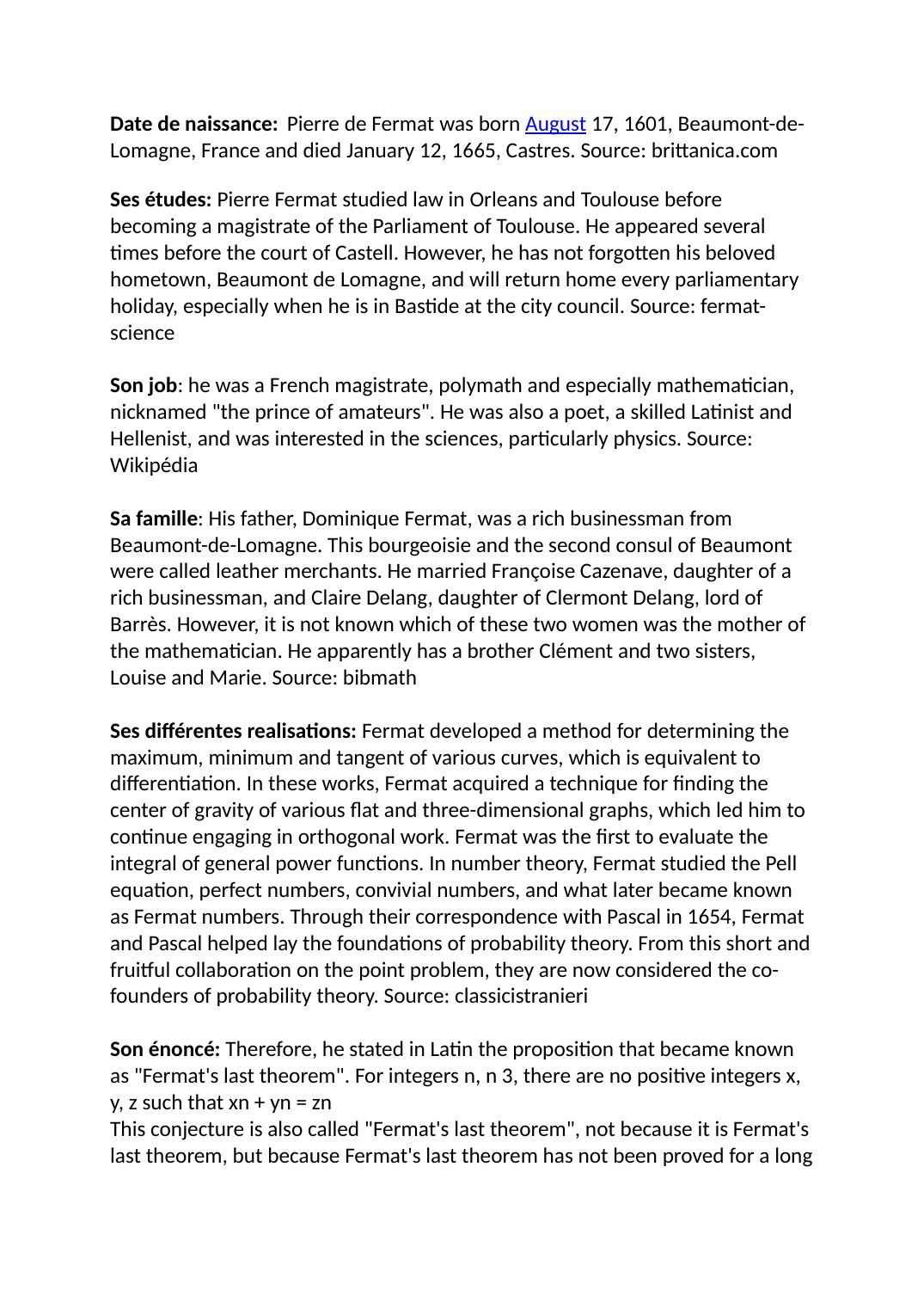pierre de fermat (anglais)
Publié le 30/12/2021

Extrait du document
«
Date de naissance: Pierre de Fermat was born August 17, 1601, Beaumont-de-
Lomagne, France and died January 12, 1665, Castres.
Source: brittanica.com
Ses études: Pierre Fermat studied law in Orleans and Toulouse before
becoming a magistrate of the Parliament of Toulouse.
He appeared several
times before the court of Castell.
However, he has not forgotten his beloved
hometown, Beaumont de Lomagne, and will return home every parliamentary
holiday, especially when he is in Bastide at the city council.
Source: fermat-
science
Son job : he was a French magistrate, polymath and especially mathematician,
nicknamed "the prince of amateurs".
He was also a poet, a skilled Latinist and
Hellenist, and was interested in the sciences, particularly physics.
Source:
Wikipédia
Sa famille : His father, Dominique Fermat, was a rich businessman from
Beaumont-de-Lomagne.
This bourgeoisie and the second consul of Beaumont
were called leather merchants.
He married Françoise Cazenave, daughter of a
rich businessman, and Claire Delang, daughter of Clermont Delang, lord of
Barrès.
However, it is not known which of these two women was the mother of
the mathematician.
He apparently has a brother Clément and two sisters,
Louise and Marie.
Source: bibmath
Ses différentes realisations: Fermat developed a method for determining the
maximum, minimum and tangent of various curves, which is equivalent to
differentiation.
In these works, Fermat acquired a technique for finding the
center of gravity of various flat and three-dimensional graphs, which led him to
continue engaging in orthogonal work.
Fermat was the first to evaluate the
integral of general power functions.
In number theory, Fermat studied the Pell
equation, perfect numbers, convivial numbers, and what later became known
as Fermat numbers.
Through their correspondence with Pascal in 1654, Fermat
and Pascal helped lay the foundations of probability theory.
From this short and
fruitful collaboration on the point problem, they are now considered the co-
founders of probability theory.
Source: classicistranieri
Son énoncé: Therefore, he stated in Latin the proposition that became known
as "Fermat's last theorem".
For integers n, n 3, there are no positive integers x,
y, z such that xn + yn = zn
This conjecture is also called "Fermat's last theorem", not because it is Fermat's
last theorem, but because Fermat's last theorem has not been proved for a long.
»
↓↓↓ APERÇU DU DOCUMENT ↓↓↓
Liens utiles
- Blondel, François Desjardins Fermat, Pierre de Fouquet, Nicolas
- Pierre de Fermat1601-1665Issu d'une famille aisée de Beaumont de Lomagne, Fermat étudia le droit à Toulouse, obtintson diplôme à Orléans en 1631 et exerça le métier de magistrat.
- Andrew Wiles par Marc CherkiJournaliste Il tord le cou à Pierre de Fermat et à son célèbre théorème, en résolvant uneénigme vieille de 350 ans.
- LA JONQUIERE, Pierre Jacques de Taffanel, marquis de (1685-1752)Marin, il livre aux Anglais (en 1747) une bataille au cap Finistère et, en 1749, est nommé gouverneur du Canada.
- FERMAT, Pierre de (1601-1665)Mathématicien, il est un précurseur dans divers domaines : calcul différentiel, géométrie analytique et calcul des probabilités.


